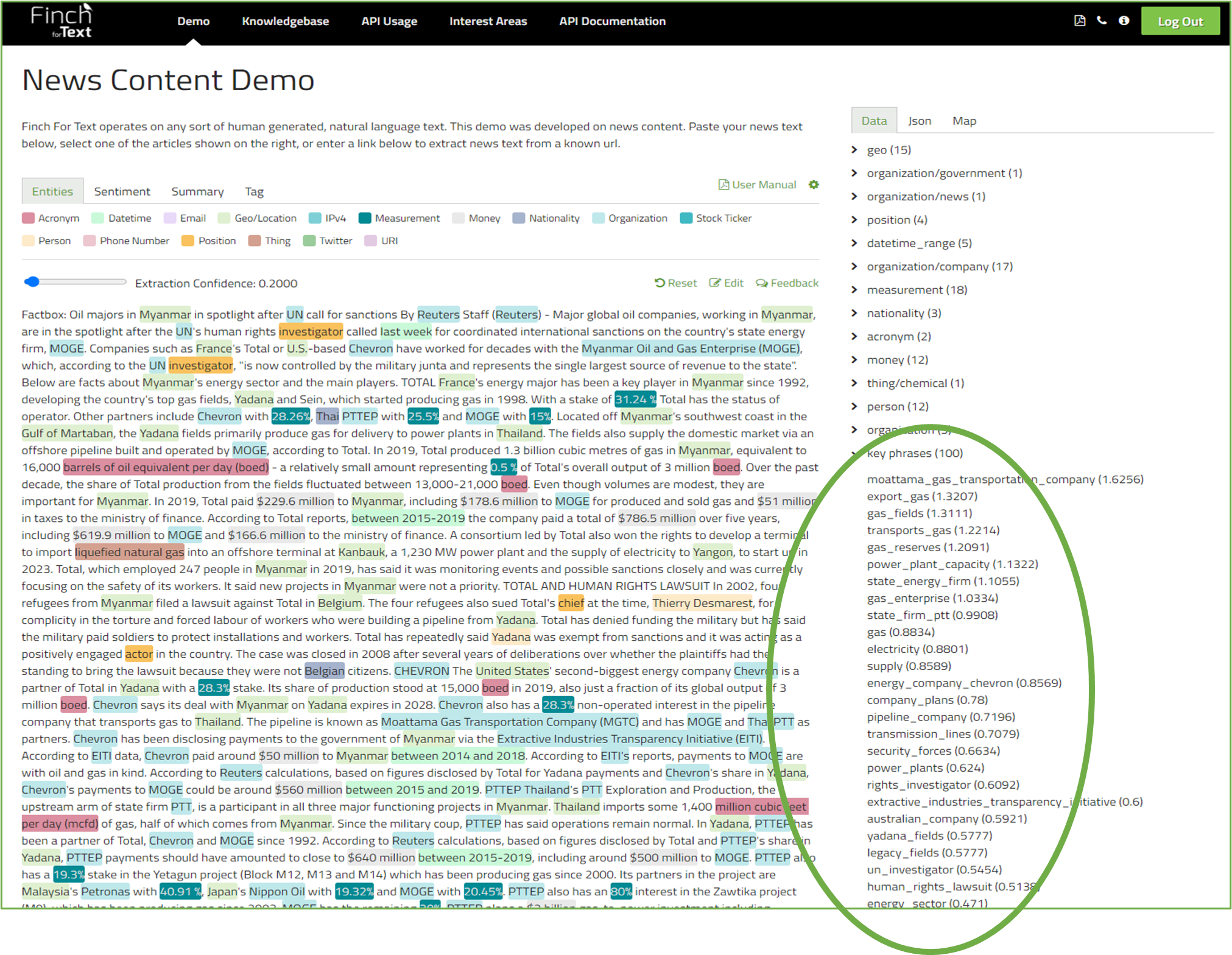From IC Insider Finch Computing
AI/ML Solutions that Deliver Actionable Insights from Data
Finch Computing has a long legacy of deriving rich geographic insights from textual data for customers through our MetaCarta software and have recently expanded our products’ breadth of analysis from multiple forms of structured and unstructured text. Today, we deliver entity analytics capabilities – extraction, disambiguation, enrichment and more –to customers across the intelligence, defense and commercial sectors.
Our data scientists and engineers have created an industry leading patent portfolio spanning text analytics, entity disambiguation, knowledge discovery, search, in-memory computing, and data compression, enabling us to innovate and deliver truly game-changing solutions to our customers.
Finch’s high-precision entity extraction, disambiguation and enrichment capabilities – across more than a dozen entity types – enable robust, sophisticated analytics for users.
At Work for OSINT Missions
For OSINT uses in particular, our Finch for Text solution is an enterprise service that can be plugged into an existing architecture in multiple places in an analyst workflow, incrementally adding value at every step. It is a RESTful API service that is reusable for different kinds of tasks that can be integrated throughout. Its open architecture and open APIs means there is no need to control or store your data as Finch for Text easily integrates with customers’ legacy database systems or modern “data lakes”.
As a sample use case, the ongoing political unrest and instability in Myanmar represents a classic OSINT mission priority, as traditional intelligence collection sources such as HUMINT and SIGINT are typically dedicated to efforts with a more direct connection to U.S. interests.
In February 2021, a coup returned Myanmar to full military rule after years of quasi-democracy. Demonstrations in protest have continued for months. The country has responded with a deadly and relentless crackdown. As of late April, the military, is responsible for the deaths of more than 700 people – including children and bystanders to the demonstrations – and the detainment of more than 3,300. The military is supported with revenue streams from multiple state-owned enterprises, as designated by the U.S. State Department.
As the situation worsens, the U.S. intelligence community must leverage all tools at its disposal to monitor the unrest. Politically, the United States is applying economic pressure on Myanmar and its state-owned enterprises by imposing sanctions. The success of those sanctions would be furthered and enhanced by answering questions such as:
- Who is doing business with these state-owned companies?
- What global brands and actors are involved?
- How can sentiment analysis enhance our understanding of both the global and local actors and their U.S. based interests?
Publicly available data sources include news and social media, rife with information that contributes to a greater understanding of these connections and their origins. Interrogating this data in real-time and with a high degree of accuracy from these public sources, is of critical importance.
Finch Computing offers a suite of text analytics software that can help answer these questions as part of a larger, user-facing, text analytics system.
Analyst Capabilities with Finch for Text
1. Quickly Identify Entities at Play in the Myanmar Crisis
From a single piece of content, Finch for Text can immediately show users the entities mentioned and the metadata about them. For example, in the solution, users can hover over a specific entity, color-coded by type, and see a “baseball card” about that entity. The baseball card includes a photo, where available, information about the entity, scores for the tool’s extraction and disambiguation accuracy and more. And it can do this in real-time and at enterprise scale.
For companies and organizations, Finch for Text can show sentiment about them as well. Users can see metadata about the entity and a red, green, or yellow sentiment score – negative, positive, or neutral respectively. Finch for Text can also show a salience score – the degree to which a piece of text is about an entity – meaning that, in an instant, an analyst can determine what a piece of text is about, what the sentiment is and the degree to which the sentiment is positive or negative.
Finch’s latest capability is relationship extraction from text content: understanding how entities are related to one another for exploration within a graph database. Understanding the non-obvious relationships between people and other entities (e.g., other people, companies, groups), sometimes several degrees of separation away, are issues that this Finch capability will reveal. There are many national security related use-cases that benefit from this analytical depth that Finch provides.
2. Leverage Text Summarization to Accelerate Analysis
Of course, when analysts notice an uptick in mentions or co-occurrence, or a change in sentiment, they will want to take a deeper dive into the pieces of text from which these signals emerge. Here, Finch for Text offers another important capability: automated summarization through artificial intelligence.
Using our proprietary approach, Finch for Text extracts key phrases from unstructured text and determines their importance to the overall document. It can make inferences in context and use those key phrases to understand whether a document, a sentence or a specific entity mention is positive or negative. This key-phrase extraction also allows us to build highly accurate topic models that allow Finch for Text to summarize an entire piece of text – shortening the time-to-value for analysts looking at multiple content pieces from disparate sources.
For every piece of text, users can see 100 key phrases or words that Finch for Text has extracted. Numbers in parenthesis next to each phrase indicate a weighting and a relationship to one another, which are ultimately used to calculate a topic model. From the same view, on the same piece of text, a user can also hover over specific entities and see more information about them.
For every piece of text, users can see 100 key phrases or words that Finch for Text has extracted. Numbers in parenthesis next to each phrase indicate a weighting and a relationship to one another, which are ultimately used to calculate a topic model. From the same view, on the same piece of text, a user can also hover over specific entities and see more information about them.

3. Deliver Immediate, Analyst-Specific Content Using Interest Areas & Topic Tagging
For analysts monitoring multiple situations at once or interrogating multiple sources of information – which is the case for most analysts in practice – Finch for Text offers a differentiated capability. Leveraging our entity analytics expertise and our unique approach to topic modeling, users can create topic-based interest areas and have content pushed to them that is about a certain topic of interest, rather than content that simply mentions it.
As an example, if a user is interested in content about the situation in Myanmar that focuses on corporate ties to state-owned enterprises there, a user could create a custom feed that delivers content on precisely that topic. To do it, a user would simply indicate whether an article is of interest or not via a thumbs-up/thumbs-down feature. Finch for Text would use the attributes of the “thumbs up” articles to find mathematically similar content and deliver that to a user in a feed. As the user “rates” each piece, he or she is effectively tuning and training a model and improving the relevancy of the content in the feed.
Additionally, a user could create multiple topics or areas of interest this way. One analyst could have curated content on Myanmar in one feed, Russia in another, and North Korea in a third. And the feed would be specific to what this individual analyst or groups of analysts is monitoring. Other analysts could create other feeds just as easily on myriad topics.
Easy Integration with Customer Systems
The entire Finch platform of modularized, open, and easily integrated and tailored services allow developers to build on their existing capabilities in an efficient and scalable way, and allows analysts to receive accurate data and insights that get better over time.
As an open API with microservices, Finch for Text is an effective tool in a developer’s toolbox as they work with classified and unclassified text-based sources to complete their missions. It is an enterprise, RESTful API service that is reusable for different kinds of tasks that can be integrated throughout the data pipeline. Its open architecture and open APIs means there’s no need to control or store your data.
Rapid Value-to-Intelligence from Open-Source Content
Among Finch for Text’s benefits is its ability to deliver rapid and unique value-to-intelligence of open-source content and its ability to process it quickly and accurately on new or emerging geopolitical events that are not routinely monitored. It’s a premier text analytics service that turns unstructured data into structured knowledge on relevant intelligence at the speed of need.
Leverage Machine Learning, NLP & Services Partners
Finch for Text uses text analytics and machine learning to enhance knowledge discovery from massive OSINT repositories. Our patented, precision entity extraction and content tagging empower automated discovery. Topic modeling services assist collection and all-source analysts in mining for new “topic patterns.” Our text summarization capabilities enhance the value and utility of user-facing, streaming text and alert services—accelerating analyst discovery of relevant knowledge from massive text repositories.
We work with partners like TVEyes and LexisNexis to bring in content; to develop and train models and to complement our customers’ datasets. We can create custom solutions using a range of modern analytics capabilities utilizing commercial or private clouds, as well as unique customer environments.
Learn More
Finch Computing solutions are being used across multiple federal agencies and subagencies specializing in intelligence and securing our national defense. Additionally, a number of private companies across finance, media and content aggregation rely on Finch Computing to support their user-facing products. Our solutions support open-source intelligence, risk monitoring, media monitoring, political bias monitoring, and alpha generation use cases, among others.
- Finch for Text: Borne from our MetaCarta software, Finch for Text expands on that product’s geographic extraction and disambiguation capabilities to identify more than a dozen entity types in text – including people, organizations, companies, ticker symbols, dates and times, and more. It uses our proprietary, context-based approach to natural language processing (NLP) to extract, disambiguate and enrich entities. Going a step further, Finch for Text can also extract key phrases and build topic models that drive its accuracy and enable additional analytics capabilities such as document, sentence and entity-level sentiment. Is JSON outputs are delivered to users in real-time or at a time of their choosing and can easily be integrated into existing tools or systems. Finch for Text offers multiple language support, with new languages added all the time and by customer request.
- Finch for Text DevSecOps: A complement to Finch for Text is the DevSecOps that goes along with it. It never goes down and is consistently fast. It can run in classified environments as a cloud-hosted SaaS and on-prem in classified environments via Docker container. It is currently accredited and running in C2S and JWICs.
- FinchDB: FinchDB is the underlying, distributed in-memory database that allows Finch for Text to operate as quickly and accurately as it does. We hold patents in data compression and in-memory computing, which enable real-time, complex analytics on data – even as it is streaming (and thus changing) by the second. This enables Finch for Text to perform analytics on huge volumes of data and, as models are tuned and trained over larger and larger corpora of data, ensures that our analytics become more precise as we ingest higher volumes of data.
- FinchDaaS: Finch Data as a Service (Daas) brings together a real-time feed of radio and television news from more than 2,500 outlets in 23 countries worldwide that is transcribed and enriched by Finch for Text. With FinchDaaS, users can easily assess the entities, sentiment and key phrases in the feed and integrate that data into their existing analytics platforms. Users can also curate the feed to align with particular topics or entities of interest, and then examine the relationships between them through graph database exploration.
To learn more about Finch Computing or any of our products, please contact us at: sales@finchcomputing.com
About Finch Computing
Finch Computing, formerly Synthos Technologies, is a division of Qbase, LLC. Finch Computing provides our customers with the ability to find hidden meaning and insight in huge volumes of data. Streaming or static. Structured or unstructured. Internal or external.
We use our unique intellectual property and knowledge assets to offer compelling, differentiated data services that help our customers make better business decisions, identify risks and opportunities, or become more competitive.
To learn more, visit us online.
About IC Insiders
IC Insiders is a special sponsored feature that provides deep-dive analysis, interviews with IC leaders, perspective from industry experts, and more. Learn how your company can become an IC Insider.









